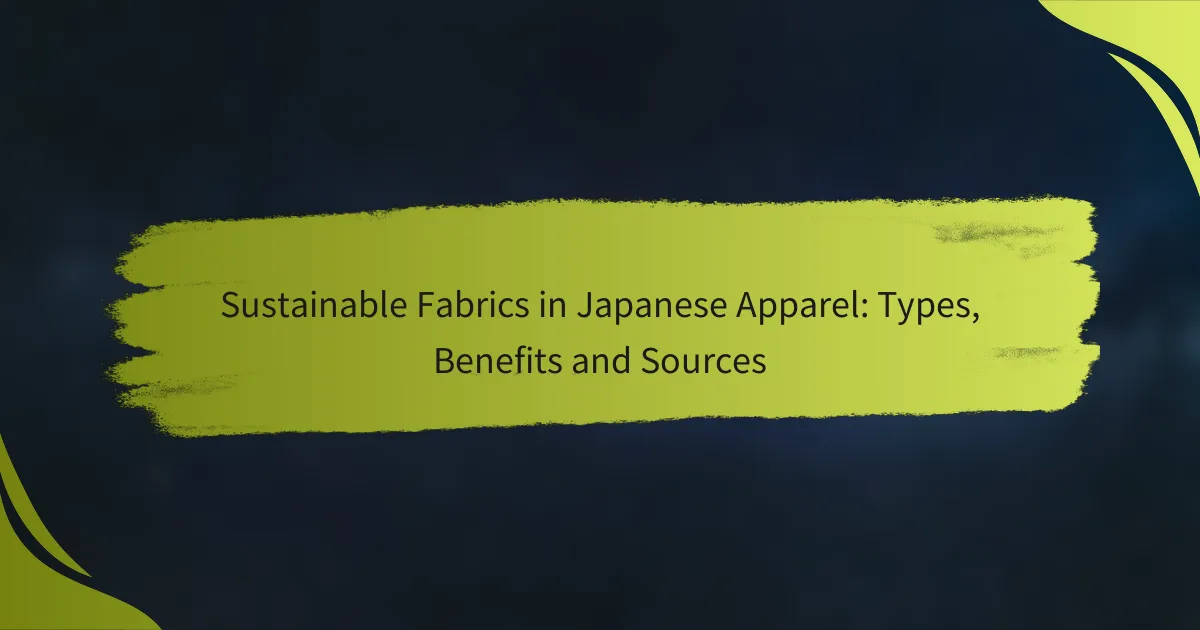日本のアパレル業界では、環境保護と社会的責任を重視した持続可能なファブリックが多様に利用されています。オーガニックコットン、ヘンプ、バンブー生地、リサイクルポリエステル、リヨセル(テンセル)など、各素材は独自の利点と用途を提供します。
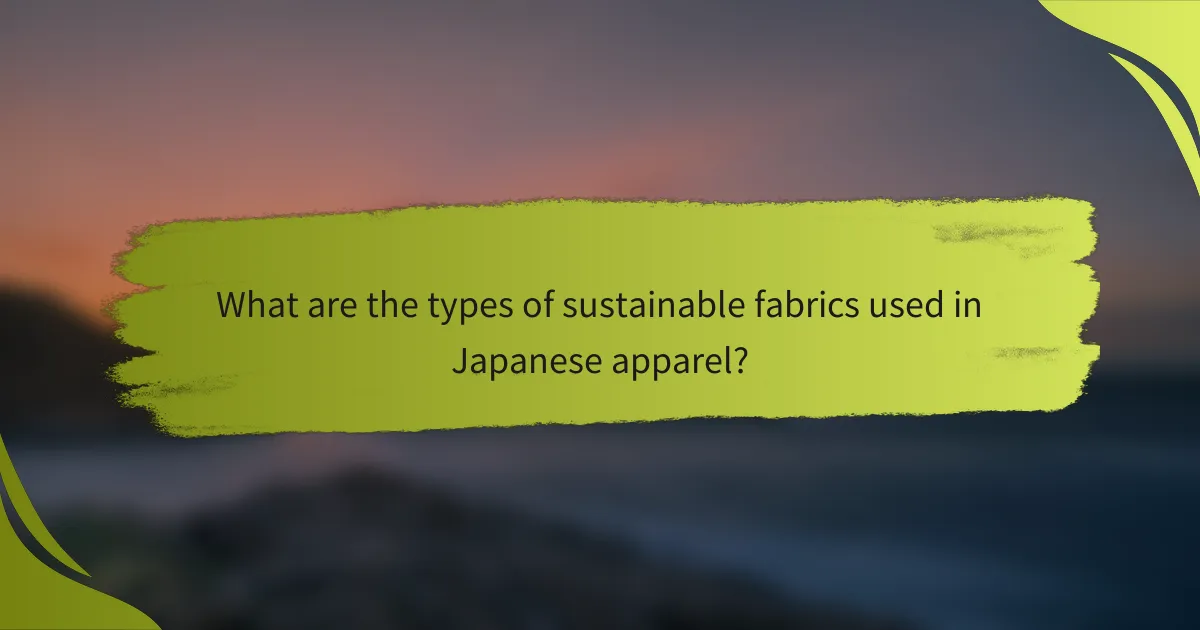
What are the types of sustainable fabrics used in Japanese apparel?
Japanese apparel utilizes various types of sustainable fabrics that prioritize environmental health and social responsibility. Key materials include organic cotton, hemp, bamboo fabric, recycled polyester, and lyocell (Tencel), each offering unique benefits and applications.
Organic cotton
Organic cotton is grown without synthetic pesticides or fertilizers, making it a healthier choice for the environment and farmers. In Japan, organic cotton is often certified by recognized standards, ensuring compliance with eco-friendly practices.
This fabric is soft, breathable, and hypoallergenic, making it suitable for sensitive skin. When choosing organic cotton apparel, look for certifications like GOTS (Global Organic Textile Standard) to ensure quality and sustainability.
Hemp
Hemp is a highly durable and versatile fabric that requires minimal water and no pesticides to grow. In Japan, hemp has a long history of use, valued for its strength and natural resistance to mold and UV light.
Hemp fabric becomes softer with each wash, making it comfortable for everyday wear. It is an excellent choice for casual clothing and accessories, but be mindful that it may wrinkle more easily than other fabrics.
Bamboo fabric
Bamboo fabric is made from the pulp of bamboo grass, which grows rapidly and requires little water. This fabric is naturally antibacterial and moisture-wicking, making it ideal for activewear and undergarments.
While bamboo is a sustainable resource, the manufacturing process can involve chemicals, so look for brands that use closed-loop systems to minimize environmental impact. Certifications like OEKO-TEX can help identify safer options.
Recycled polyester
Recycled polyester is made from post-consumer plastic bottles and other plastic waste, reducing landfill contributions and resource consumption. In Japan, many brands are adopting this fabric to create stylish and functional garments.
This material is lightweight, durable, and quick-drying, making it suitable for outdoor and sports apparel. When selecting recycled polyester, check for certifications like RCS (Recycled Claim Standard) to ensure authenticity.
Lyocell (Tencel)
Lyocell, commonly known by the brand name Tencel, is produced from sustainably sourced wood pulp, primarily from eucalyptus trees. The closed-loop production process recycles water and solvents, minimizing waste and environmental impact.
Lyocell is soft, breathable, and biodegradable, making it a popular choice for eco-conscious consumers. It drapes beautifully, making it suitable for both casual and formal wear, and is often blended with other fibers for enhanced performance.
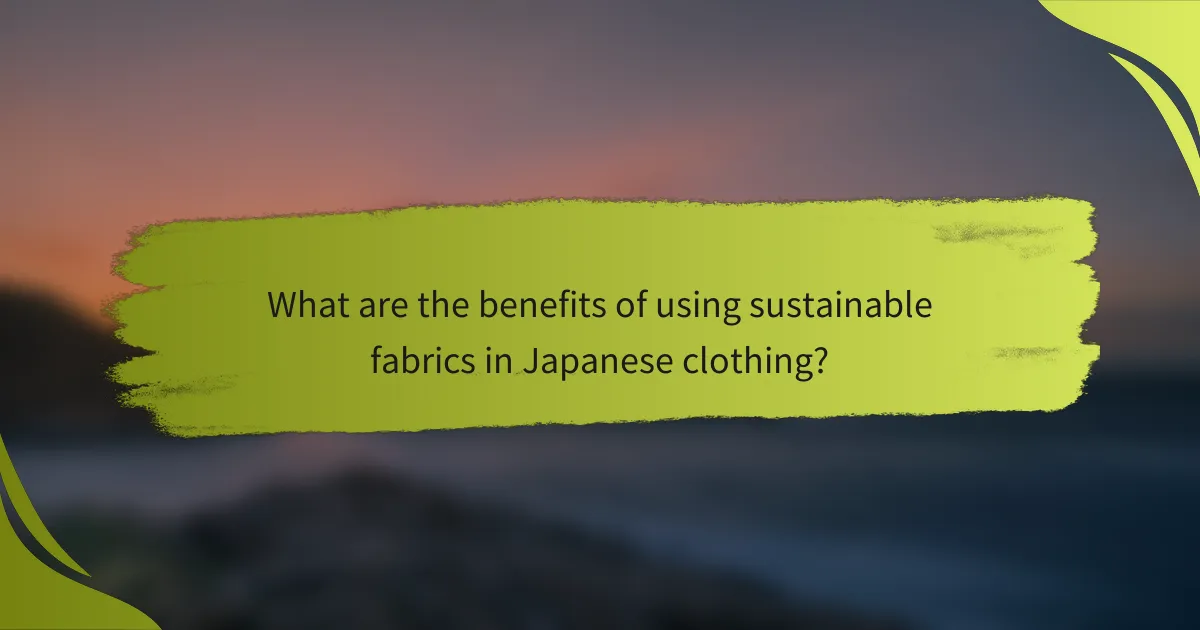
What are the benefits of using sustainable fabrics in Japanese clothing?
Sustainable fabrics in Japanese clothing offer numerous advantages, including environmental preservation, enhanced durability, health benefits for consumers, and support for local economies. By prioritizing these materials, the apparel industry can contribute positively to both society and the planet.
Environmental impact reduction
Using sustainable fabrics significantly reduces the environmental footprint of clothing production. Materials like organic cotton, hemp, and recycled polyester require less water and energy compared to conventional fabrics. This shift helps decrease pollution and resource depletion, aligning with Japan’s commitment to sustainability.
Additionally, many sustainable fabrics are biodegradable or recyclable, which minimizes waste in landfills. This is particularly relevant in Japan, where waste management and recycling are critical issues.
Improved durability
Sustainable fabrics often boast superior durability compared to traditional options. For instance, materials like Tencel and organic cotton are designed to withstand wear and tear, leading to longer-lasting garments. This durability translates to fewer replacements and less waste over time.
Investing in high-quality, sustainable clothing can save consumers money in the long run, as they won’t need to frequently replace damaged or worn-out items. This is a practical consideration for Japanese consumers who value quality and longevity in their apparel.
Health benefits for wearers
Sustainable fabrics are typically free from harmful chemicals and pesticides, which can pose health risks to wearers. Organic cotton, for example, is grown without synthetic fertilizers, making it gentler on the skin. This is especially important for those with sensitivities or allergies.
Moreover, many sustainable fabrics are breathable and moisture-wicking, enhancing comfort during wear. This is a significant advantage for consumers in Japan, where seasonal changes can affect clothing needs and comfort levels.
Support for local economies
Choosing sustainable fabrics often means supporting local artisans and manufacturers in Japan. This practice not only fosters community development but also helps preserve traditional textile techniques that are at risk of being lost.
By investing in locally sourced materials, consumers can contribute to the economic stability of their communities. This is particularly relevant in regions known for their textile production, such as Okayama and Nishijin, where craftsmanship and sustainability go hand in hand.
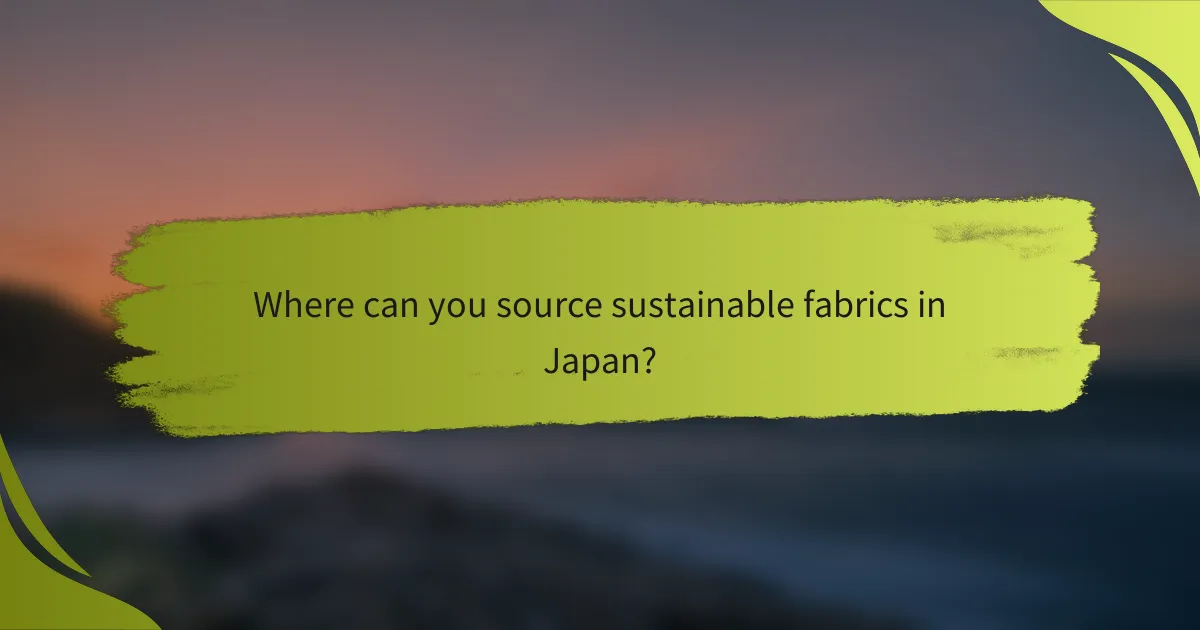
Where can you source sustainable fabrics in Japan?
In Japan, sustainable fabrics can be sourced from various local manufacturers, online stores, and eco-friendly fashion brands. These options provide a range of materials that prioritize environmental responsibility and ethical production practices.
Local textile manufacturers
Japan is home to numerous local textile manufacturers that specialize in sustainable fabrics. Many of these companies focus on traditional techniques, such as organic cotton weaving or natural dyeing, which minimize environmental impact. Notable regions include Okayama for denim and Nishijin for silk, both renowned for their craftsmanship.
When sourcing from local manufacturers, consider visiting textile fairs or exhibitions, which often showcase sustainable options. Engaging directly with producers can also provide insights into their sourcing practices and material origins.
Online sustainable fabric stores
Several online platforms in Japan offer a wide selection of sustainable fabrics. Websites like Fabric Tokyo and Kokka provide eco-friendly options, including organic cotton and recycled materials. These stores often feature detailed descriptions of the fabrics, including their certifications and environmental benefits.
When shopping online, look for stores that provide transparency about their supply chain and sustainability practices. Reading customer reviews can also help gauge the quality and reliability of the fabrics offered.
Eco-friendly fashion brands
Many eco-friendly fashion brands in Japan prioritize the use of sustainable fabrics in their collections. Brands like Muji and Nitori focus on minimalistic designs while ensuring their materials are sourced responsibly. These brands often highlight their commitment to sustainability through various certifications.
To support sustainable fashion, consider purchasing from brands that openly share their environmental impact and production processes. This not only promotes ethical consumption but also encourages more brands to adopt sustainable practices.
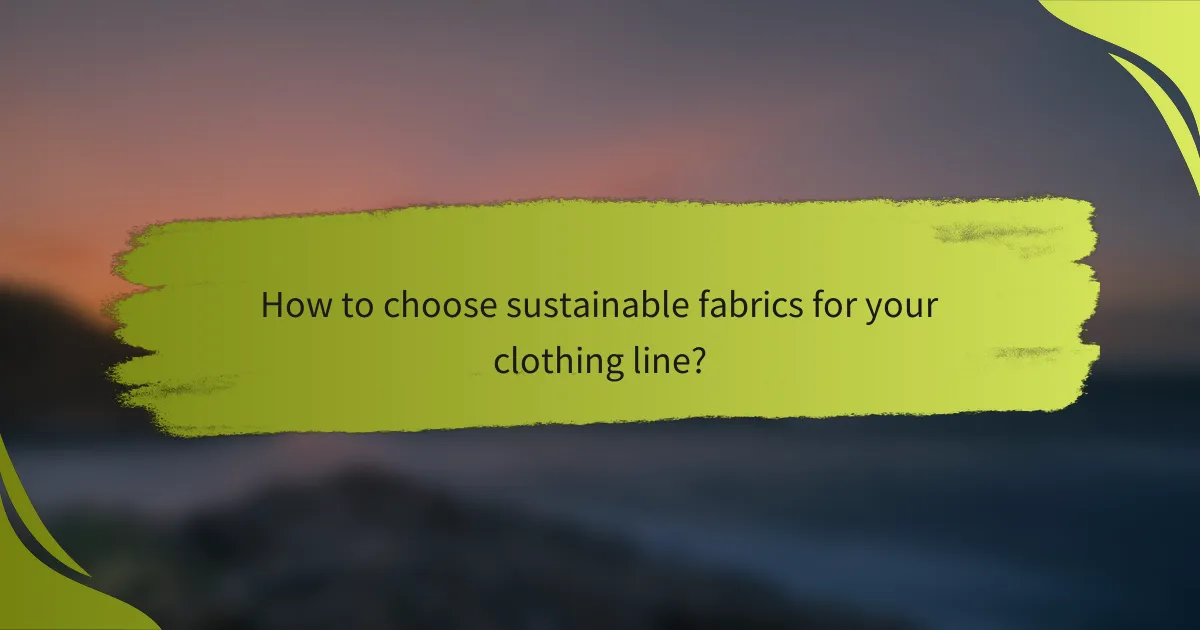
How to choose sustainable fabrics for your clothing line?
Choosing sustainable fabrics for your clothing line involves assessing various factors such as material certifications, production processes, and end-of-life options. Prioritizing these aspects helps ensure that your apparel is environmentally friendly and socially responsible.
Assess material certifications
Material certifications indicate the sustainability and ethical sourcing of fabrics. Look for certifications such as GOTS (Global Organic Textile Standard), OEKO-TEX, and Fair Trade, which provide assurance about organic content and safe production practices.
When evaluating certifications, consider the specific claims they make. For example, GOTS ensures organic fibers and fair labor practices, while OEKO-TEX focuses on harmful substance testing. This clarity helps you choose fabrics that align with your sustainability goals.
Evaluate production processes
Understanding the production processes of fabrics is crucial for sustainability. Investigate whether the manufacturing methods use eco-friendly dyes, reduce water consumption, and minimize waste. Techniques like waterless dyeing or closed-loop systems can significantly lower environmental impact.
Additionally, consider the geographical location of production. Fabrics produced locally can reduce transportation emissions and support local economies. However, ensure that local practices meet sustainability standards to maintain integrity in your clothing line.
Consider end-of-life options
End-of-life options for fabrics are essential for sustainable fashion. Evaluate whether the materials can be recycled, composted, or biodegraded. Fabrics like organic cotton or Tencel often have better end-of-life profiles compared to conventional synthetics.
Implementing a take-back program or encouraging customers to return used garments can enhance sustainability. This approach not only reduces waste but also fosters a circular economy, allowing you to reclaim materials for future use in your clothing line.
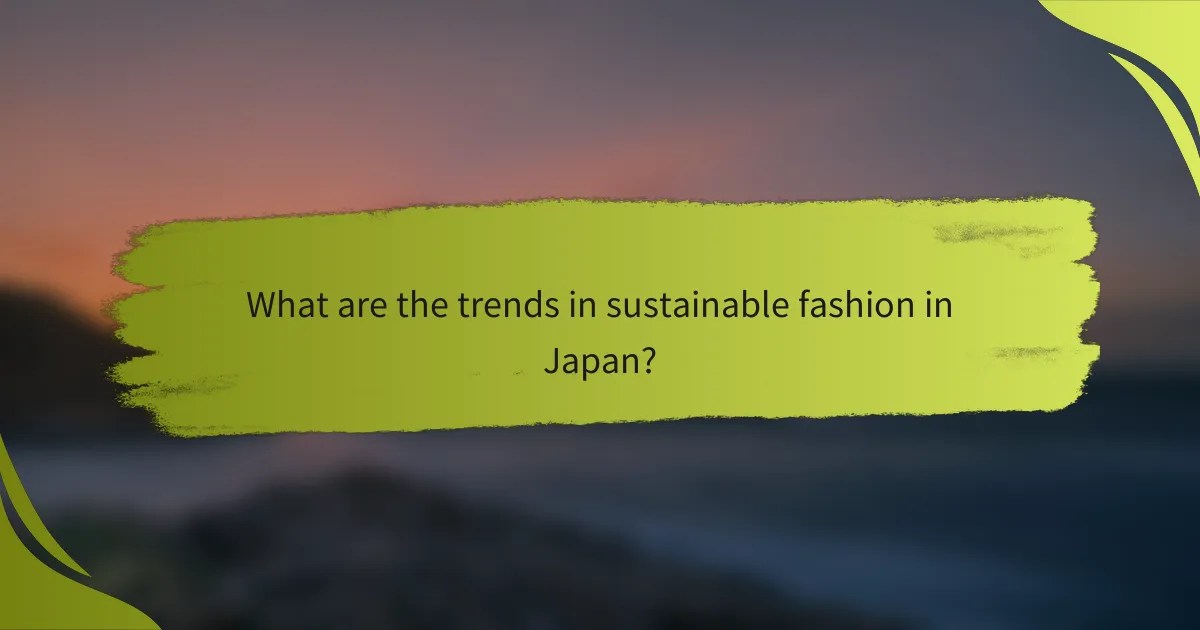
What are the trends in sustainable fashion in Japan?
In Japan, sustainable fashion is increasingly focused on eco-friendly materials, ethical production practices, and reducing waste. Brands are adopting innovative approaches to create clothing that minimizes environmental impact while appealing to conscious consumers.
Types of Sustainable Fabrics
Japanese apparel brands are utilizing various sustainable fabrics, including organic cotton, hemp, and Tencel. Organic cotton is grown without harmful pesticides, making it a safer choice for both the environment and farmers. Hemp is known for its durability and low water requirements, while Tencel, made from sustainably sourced wood pulp, offers a soft feel and biodegradability.
Recycled materials are also gaining traction, with brands incorporating fabrics made from post-consumer waste, such as recycled polyester. This not only reduces landfill waste but also lessens the demand for virgin materials, contributing to a circular economy.
Benefits of Sustainable Fabrics
Sustainable fabrics offer numerous benefits, including reduced environmental impact and improved health for consumers. By using organic materials, brands can decrease soil and water pollution, promoting a healthier ecosystem. Additionally, sustainable fabrics often have a lower carbon footprint compared to conventional textiles.
Consumers can also enjoy the advantages of durability and comfort. Many sustainable fabrics are designed to last longer, reducing the need for frequent replacements. This not only saves money in the long run but also aligns with the principles of mindful consumption.
Sources of Sustainable Fabrics in Japan
Japan has a growing network of suppliers and manufacturers specializing in sustainable fabrics. Local farms produce organic cotton, while companies like Asahi Kasei and Toray Industries are leading the way in developing innovative, eco-friendly textiles. These suppliers often adhere to strict environmental standards, ensuring that their products are both sustainable and high-quality.
Additionally, many Japanese brands are collaborating with international organizations to source sustainable materials. This global approach allows them to access a wider range of eco-friendly fabrics while supporting sustainable practices worldwide.
